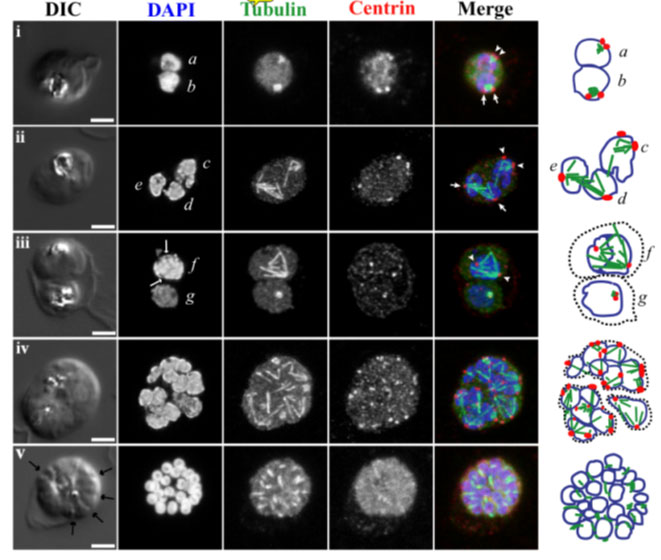Fluorescence light microscopy images of mitotic 450 spindle during blood stage schizogony in P. falciparum parasites. 3D confocal microscopy views of blood-stage P.f. parasite cell morphology (DIC microscopy), nuclei (DAPI, blue in merged images), mitotic spindle (anti-alpha tubulin antibody, green in merged images), and mitotic spindle MTOCs (anti-PfCEN3 antibody in panels i, ii, iv, and v or anti-Cr Centrin1 antibody 20H5 in panel iii, red in merged images). Schematic cartoons are drawn for each example indicating spindle MTOCs (red circles), microtubules (green lines), and outlines of stained DNA (blue lines). Dotted black lines indicate separate parasites in multiply infected host cells. Panel i, a-b) Short mitotic spindles bounded by MTOCs. The spindle in nucleus b which resembles an oblong tubulin spot has a pole-to-pole distance that is approximately 1 micron long. Panels ii-iii, c-f) Larger spindle structures. In d and e, spindle extends across separate nuclear bodies. In f, a dark line is visible down the center of the DAPI-stained DNA near the spindle midzone (DAPI, arrows). Panel iv) Asynchronous schizont nuclei have spindles with different geometries in multiple stages of extension. Panel v) Segmented parasites after the final mitosis of schizogony. Furrows are visible between daughters (arrows), nuclei are condensed, and microtubules appear in the daughter cytoplasms. Panel i is a single confocal slice from a 3D series. Panels ii-v are maximum projection images of full 3D series. Panels ii-iv were processed with deconvolution software. Scale bar = 2 microns.
Gerald N, Mahajan B, Kumar S. Mitosis in the human malaria parasite Plasmodium falciparum. Eukaryot Cell. 2011 10(4):474-82.
Other associated proteins
| PFID | Formal Annotation |
|---|---|
| PF3D7_1027700 | centrin-3 |
